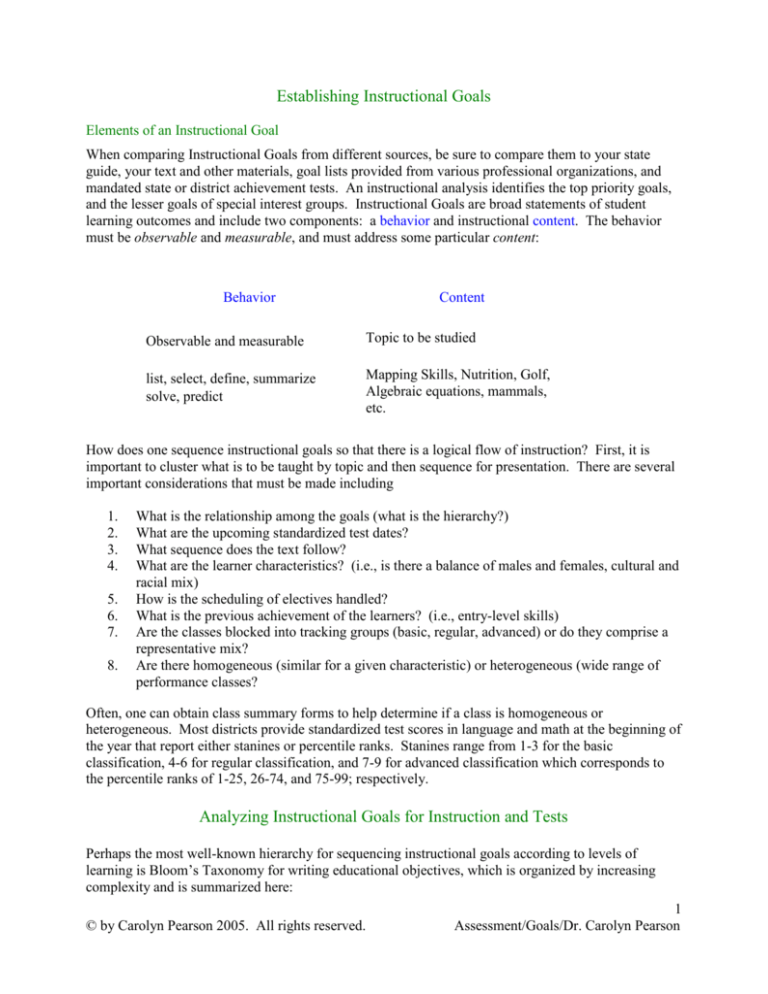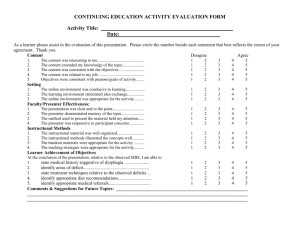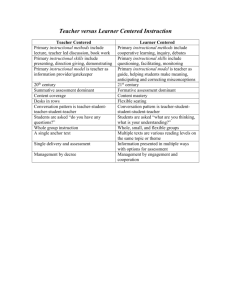
Establishing Instructional Goals
Elements of an Instructional Goal
When comparing Instructional Goals from different sources, be sure to compare them to your state
guide, your text and other materials, goal lists provided from various professional organizations, and
mandated state or district achievement tests. An instructional analysis identifies the top priority goals,
and the lesser goals of special interest groups. Instructional Goals are broad statements of student
learning outcomes and include two components: a behavior and instructional content. The behavior
must be observable and measurable, and must address some particular content:
Behavior
Content
Observable and measurable
Topic to be studied
list, select, define, summarize
solve, predict
Mapping Skills, Nutrition, Golf,
Algebraic equations, mammals,
etc.
How does one sequence instructional goals so that there is a logical flow of instruction? First, it is
important to cluster what is to be taught by topic and then sequence for presentation. There are several
important considerations that must be made including
1.
2.
3.
4.
5.
6.
7.
8.
What is the relationship among the goals (what is the hierarchy?)
What are the upcoming standardized test dates?
What sequence does the text follow?
What are the learner characteristics? (i.e., is there a balance of males and females, cultural and
racial mix)
How is the scheduling of electives handled?
What is the previous achievement of the learners? (i.e., entry-level skills)
Are the classes blocked into tracking groups (basic, regular, advanced) or do they comprise a
representative mix?
Are there homogeneous (similar for a given characteristic) or heterogeneous (wide range of
performance classes?
Often, one can obtain class summary forms to help determine if a class is homogeneous or
heterogeneous. Most districts provide standardized test scores in language and math at the beginning of
the year that report either stanines or percentile ranks. Stanines range from 1-3 for the basic
classification, 4-6 for regular classification, and 7-9 for advanced classification which corresponds to
the percentile ranks of 1-25, 26-74, and 75-99; respectively.
Analyzing Instructional Goals for Instruction and Tests
Perhaps the most well-known hierarchy for sequencing instructional goals according to levels of
learning is Bloom’s Taxonomy for writing educational objectives, which is organized by increasing
complexity and is summarized here:
© by Carolyn Pearson 2005. All rights reserved.
1
Assessment/Goals/Dr. Carolyn Pearson
1.
2.
3.
4.
5.
6.
Knowledge - simple recall, memorization of info.
Comprehension - paraphrasing, translates or interprets.
Application - solves problems by applying a rule, procedure. (ex: formula
Analysis - divide into smaller parts to see relationships. (ex: plot of story)
Synthesis - combines and integrates parts to form whole. (ex: essay paper)
Evaluation - judge quality of work according to some criteria.
Of course, there are other types of learning theories, and one that was discussed earlier was Robert
Gagne' who came up with his own learning blueprint. Gagne' organizes learning into:
Intellectual Skills, which is defined as the use of symbols, differentiating, classifying, or problem
solving (also known as procedural knowledge) and further defines them into Discrimination, in
which the learner recognizes differences in objects based on their physical characteristics (e.g.,
nickels and dimes, they are shaped and feel differently); and Concepts, which may be either
concrete (physical properties allow recognition and classification generalization such as the general
category of cats and dogs) or defined (includes physical characteristics also, but includes a
relationship (i.e., a person may be not only a teacher but a father, you would have to know what
they do and how they relate to other people), or, a vase (classification) holds flowers (function);
rules, which are propositions that govern our behavior towards stimuli and determines our response
(language and math are rule-governed skills); and principles, concepts that are combined and
relationships are used to explain phenomena, such as prediction (concept may be causal, i.e., poor
eating causes indigestion, or correlational, smoking positively associated with getting lung cancer).
There are two other learning classifications that Gagne' derived; one is Verbal Information, which
represents declarative knowledge, i.e., names and labels, and are made through consistent
associations. For example X is the symbol for average, and + means to add. There are facts, such
as the hours that something is open, or you know what a particular building is, or having to take this
course. When analyzing goals for verbal information you must organize the information according
to frameworks (schemata) and cluster similar facts together. Gagne' also derived Motor Skills,
which requires coordination of muscular movement that is separated into action steps or what is
also know as part skills, and Attitudes, which is a choice of personal action that is affective (positive
or negative feelings), behavioral (result from feelings and knowledge) and cognitive (how to do
something and the reward for doing it).
For our purposes, we are interested in analyzing goals that are intellectual skills, and the goal, which is
the most complex skill, appears at the top of the hierarchy. If hierarchy is related, then subordinate
skills are placed beneath. Skills that are subordinate, yet not hierarchically related, are placed side-byside. Directly below is an example of how a skill would be organized if the relationship was
hierarchical:
© by Carolyn Pearson 2005. All rights reserved.
2
Assessment/Goals/Dr. Carolyn Pearson
Below is an example of how skills would be organized if the relationship was not hierarchical:
Capitalize
proper nouns
Give several
examples of
proper nouns
Capitalize
any word
Chronological tasks are placed side-by-side, and are usually procedures:
Locate city
left row
Locate city
in column
Locate city
in column
Find
intersection
There are three steps for analyzing goals that are intellectual skills, first, you must identify and
sequence the main components in the goal by stating the principle clearly and then break it into
components. For example, what if we wanted to teach a goal titled Capitalize proper nouns. We must
start by identifying the component relationship, and as you can see, learning to capitalize words can be
learned independently of learning words that are proper nouns; thus, the relationship is nonhierarchical.
Capitalize + proper nouns
(not hierarchically related)
Second, we must break down all main concepts of each main component, and then sequence the
elements according to their relationships. The learner must, however, learn nouns before they can learn
what a proper noun is. In this case the relationship is hierarchical:
Proper nouns
nouns
Third, we must combine the concepts with behaviors to specify the learning tasks. Specific behaviors
indicate what the students are to do with the concepts, and the behaviors can be hierarchically related:
© by Carolyn Pearson 2005. All rights reserved.
3
Assessment/Goals/Dr. Carolyn Pearson
Capitalize
proper nouns
Capitalize
any word
Identify
proper nouns
Identify
nouns
So how do we turn the goal framework into behavioral objectives? A behavioral objective is nothing
more than a statement of an intended learning outcome and must include the subordinate skill that is to
be learned, the conditions for acceptable performance, and a specific behavior that is measurable.
Conditions indicate what the students are given to perform a task such as
Given a list…
Given several examples…
From memory…
and performance criteria indicate how well the task is to be performed such as
80% of the time…
correct to within one foot…
All of these come together, for example, as:
condition
behavior
content
From memory, the student will be able to state the rule for capitalizing proper nouns.
Assessment and the Instructional Process
Instructional decisions from assessment data
Most students are tested by classroom teacher selected tests or tests teachers construct from materials
furnished by textbook publishers. Teachers assess more than content knowledge including behaviors,
attitudes, and products. Teachers ask such questions as:
1. Does the required instruction match the students and should they be group according to ability
(student entry characteristics)?
2. Are the students ready for the next learning task (prerequisite skills)?
3. Are the students progressing through the lesson adequately (practice skills)?
4. Are the students mastering the skills required of the instruction (post-testing)?
5. Is the instruction effective (formative evaluation of the lesson and the tests)?
6. What grades should be assigned when instruction is complete (summative evaluation)?
© by Carolyn Pearson 2005. All rights reserved.
4
Assessment/Goals/Dr. Carolyn Pearson
7. How is progress communicated where others understand the instructional process (portfolio
assessment)?
Assessment is a general term that includes all procedures used to gain information regarding student
learning (e.g., observations, performance ratings, product assessment, content tests), and tests and
instruments are not the same thing. Instruments are tools that gain scores that indicate where a person
lies on a continuum regarding some construct (e.g., anxiety) and have no right or wrong answers. Tests
are instruments that measure something specific (e.g., content knowledge) and have right or wrong
answers and are intended to yield criterion-referenced (mastery of objectives) and norm-referenced
(standing in a group) information. Measurement is the process of assigning numbers to an instrument
or test according to a systematic rule.
Assessment as a process is a clear specification of what is to be assessed, is relevant to the provided
activity and students, is comprehensive in that more than one tool is used so that the measure directly
links to the task performed, is properly used in that limitations of any one instrument is recognized, and
is linked to a useful purpose (systematic design of instruction).
The Systematic Design of Instruction
A contemporary view of instruction is that it is a systematic process in which every component (i.e.,
teachers, learners, materials, learning environment) is crucial to successful learning and all parts of the
process are interrelated and are directed towards a defined goal. Even the instructional process is
thought of as a system in that there is design, development, implementation, and evaluation of
instruction and a myriad of models have been developed and are often referred to Instructional Systems
Development (ISD). The term instructional design is an umbrella term that includes all the phases
associated with the ISD process. Of most importance is the instructional strategy component of the
model as it describes how the instructional designer used information from the analysis of what is to be
taught to formulate a plan for presenting instruction to the learners. The instructional design model
presented here, developed by Dick and Carey (Dick, Carey, & Carey, 2001), draws heavily from the
work of Robert Gagne', which was based on an assumption from behavioral psychology, where
instruction is the reinforcement of appropriate learner responses to stimulus situations set up by the
teacher. If learning occurs, then it is likely that they will exhibit desired behaviors in a given situation
and will continue to engage in the learning process. Gagne' incorporated cognitive informationprocessing theory which is assumed to be very complex and controlled by a person’s internal mental
processes rather than external stimuli and reinforcements; and instruction is viewed as a means of
organizing and providing sets of information and activities that guide, support, and augment students’
internal mental processes. Learning is said to have occurred when students have incorporated new
information into their memories that enable them to master new knowledge and skills.
Another branch of cognitive psychology that has influenced instructional designers is constructivism,
where learning is the product “constructed” as each learner combines new information with existing
knowledge and experiences. Learning has occurred when learners have constructed new interpretations
of the social, cultural, physical, and intellectual environments in which they live, and because learning
is so entwined with experience, the role of the teacher is to create appropriate learning environments in
which learning experiences are authentic representations of real practices in applied settings.
The Dick and Carey systematic design of instruction model has the following components: analyze the
learners and contexts, write performance objectives, develop assessment instruments, develop the
© by Carolyn Pearson 2005. All rights reserved.
5
Assessment/Goals/Dr. Carolyn Pearson
instructional strategy, develop and select instructional materials, design and conduct formative
evaluation of instruction, revise instruction, and design and conduct summative evaluation
Assess Needs to Identify Goal(s) - The first step is to determine what you want the learners to be
able to do when they have completed the lesson. The goal can be identified from a variety of
sources, but is most often obtained from district goals that are aligned with state standards.
Conduct Instructional Analysis - After the instructional goal is identified, you determine step-bystep what the learner is to do when they perform that goal. The instructional analysis determines
what skills, knowledge, and attitudes are required (known as entry behaviors) are required in order
to begin the instruction (procedural diagram we will learn in the next lesson).
Analyze Learners and Contexts - A parallel analysis to conducting the instructional analysis, the
context in which the learner will learn the skills is determined. Learners’ current skills,
preferences, and attitudes are determined along with the characteristics of the instructional setting
and the setting in which the skills will be eventually used.
Write Performance Objectives - Based on the instructional analysis diagram and entry behaviors,
specific statements are written of what the learners will be able to do when they complete the
instruction. These statements are derived straight from the skills identified from the instructional
analysis, will identify the skills to be learned, the conditions under which the skills must be
performed, and the criteria for successful performance.
Develop Assessment Instruments - Based on the written objectives, assessments that parallel and
measure the learners’ ability to perform are written.
Develop Instructional Strategy - Based on the preceding steps listed above, a strategy is identified
that will include pre-instructional activities, presentation of information, practice and feedback,
testing, and follow-through activities. The strategy is based on learning theory, the medium in
which the instruction will be delivered (classroom-based or online instruction), the content to be
taught, and the characteristics of the learners. All of these features are used to develop or select
materials or activities for interactive instruction.
Develop and Select Instructional Materials - The instructional strategy is used to produce the
instruction and typically includes a learner’s manual, materials, and tests. Materials refers to
instructor’s guides, student modules, overhead transparencies or PowerPoint presentations,
videotapes or DVD’s, computer-based multimedia format, or web pages if online or distance
learning. Obviously, the decision to develop original materials will depend on learning task and
the availability of existing relevant materials, and available resources.
Design and Conduct Formative Evaluation of Instruction - During instruction, an evaluation is
conducted to determine instructional effectiveness, i.e., determining what is effective and
ineffective and at what specific point this occurred.
Revise Instruction - The data from the formative evaluation is used to diagnose and modify the
instructional strategy. An attempt is made to identify learner difficulties in achieving the
objectives and link them to specific deficiencies in the instruction.
© by Carolyn Pearson 2005. All rights reserved.
6
Assessment/Goals/Dr. Carolyn Pearson
Design and Conduct Summative Evaluation – Although not actually a part of the instructional
design process, it is an evaluation of the relevant worth of the instruction and is usually performed
by an external evaluator.
© by Carolyn Pearson 2005. All rights reserved.
7
Assessment/Goals/Dr. Carolyn Pearson








